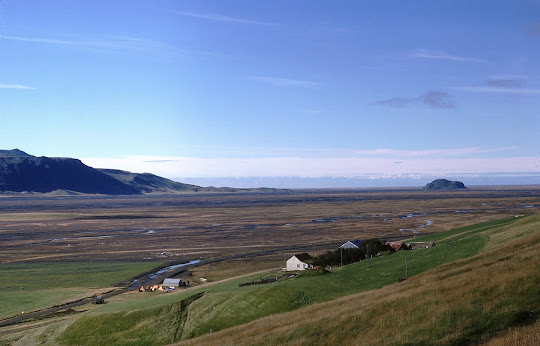links to: introduction and index - previous day - next day
Sunday 4th September 1977
 |
| Leaving Einhryningur |
Our last day of walking, on the move again from Einhryningur to the Fljótsdalur youth hostel. The route drops from the mountains into the Markarfljót valley. Ahead of us, to the south, the ice cap over the Eyjafjallajökull volcano shimmers in the sunlight. The volcano, you may recall, would later erupt in 2010 causing enormous disruption to air travel across western and northern Europe.
As we descend from the mountains, the Markarfljót valley looks like a dry estuary with a stranded island. You expect the tide to come in, but Paul says it has not done so for hundreds of years. The estuary is filled with an outwash ‘sandur‘ plain, the Markarfljótsaurar, consisting of sand, clay and other glaciofluvial deposits from the Mýrdalsjökull and Eyjafjallajökull glaciers.
Along the plain is a long flat road to the hostel. I talk to Tony for a while. He is a mature student who used to work in stockbroking. He had to overcome a lot of prejudice on switching to the lower status of trainee design technology teacher. He seems very happy and content. I take encouragement from this, being about to switch from accountant to psychology student. Nearly everyone on the walk has been to university, and all say they would have got more out if it as mature students.
Ed falls further and further behind as the day goes on. He deserves a medal for finishing. As he sits with eyes closed, someone says he looks as if he is trying to escape from reality. “What do you mean?” he replies, opening his eyes. “This is reality.”
 |
| Fljótsdalur |
The youth hostel at Fljótsdalur (meaning: River Valley) is an old farm house converted by Dick Phillips, the tour organiser. It feels as if we have returned to civilisation out of the wilderness. There are tables, chairs, cutlery, crockery, bookshelves with an extensive collection of books about Iceland, hydro-electric power and comfort. Yet it is still isolated. Many years later, interviewed by BBC Radio Stoke, Paul said of Fljótsdalur: “The silence is broken only by the booming call of a Whooper Swan, or the whirring wingbeats of a Red-Necked Phalarope...”
The hostel lies on the northern side of the Markarfljót plain between the Tindfjallalajökull and Eyjafjallajökull ice caps. Dick said he imagined Icelandic farmers of times past sitting out the
dark days of winter, waiting for the first sight of the spring sun above
the lowest point of Eyjafjallajökull.
 |
| Eyjafjallajökull from Fljótsdalur |
Here is the map of the second half of the route on which the last five huts are indicated by blue arrows (click here for a greatly enlarged version):
(next part)
Some names and personal details have been changed. I would be delighted to hear from anyone who was there.









